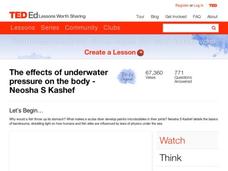Curated Video
Estados de la Materia - Sólidos, Líquidos y Gases
Aprende los conceptos básicos sobre los tres estados de la materia más conocidos: sólidos, líquidos y gases. ¿Qué es un estado de la materia? ¿Cuáles son las propiedades de los sólidos, líquidos y gases? La voz en este video es generada...
TED-Ed
Periodic Videos
From hydrogen to ununoctium, this collection of videos has everything you need to begin teaching about the periodic table. Offering descriptions of each element and interesting experiments...
TED-Ed
Turbulence: One of the Great Unsolved Mysteries of Physics
While airlines acknowledge turbulence, scientists have yet to solve the mysteries of these air currents. Find out what is known with a short video that explores the complex nature of turbulence.
JFR Science
Gas Laws: Why Do My Tires Deflate in Winter?
How many phenomena in the natural world can you explain through the relationship between temperature, pressure, and volume? Science scholars explore the gas laws with a video from JFR Science. Topics include manipulating gas laws...
JFR Science
Gas Stoichiometry: How Does an Airbag Work?
Airbags save lives ... and combining the Gas Laws and stoichiometry saves time. Find out how airbags inflate using a video from JFR Science. Topics covered include the Ideal Gas Law, standard temperature and pressure, and how to combine...
Teacher's Pet
Gases and Gas Laws
Ready to expand your chemistry class' knowledge of the gas laws? Science scholars explore the relationship between temperature, pressure, volume, and moles in a well-rounded tutorial. The narrator covers a variety of topics, including...
Teacher's Pet
Gas Mixtures and Movements
Why do balloons go flat over time? The answer lies in the behavior of gases! Introduce young scientists to diffusion and effusion with a video. Pupils learn the composition and partial pressures of atmospheric gases as well as how the...
Teacher's Pet
Properties of Gases
What makes gases so unique? Physical science sleuths uncover the facts about gases in a short video. The narrator compares gases to solids and liquids in terms of space between particles, compressibility, and reaction to temperature...
Fuse School
Diffusion of Gases
Phew, what's that smell? And, how does something like a scent travel from its source to all corners of a room? Science sleuths learn how diffusion is responsible for spreading odors around in the sixth installment in a 14-part video...
Fuse School
Extraction of Oxygen and Nitrogen from Liquid Air
Discover the process for extracting gases from the air. A 35-part lesson series continues with a discussion of fractional distillation. The instructor explains how to cool air to a liquid state and then slowly warm the air to collect...
Fuse School
Testing for Hydrogen, Oxygen, Carbon Dioxide, Ammonia, and Chlorine
How can a chemist tell what gas a chemical reaction produced? Part two of a ten-part series prompts pupils to discover a number of simple tests that can reveal the identity of a gas. The video reinforces the concepts of solubility,...
Fuse School
Collecting and Identifying Gases
How do you catch something that can't be seen, has no odor, and makes no sound? Discover the common methods of gas collection in this first of a ten-part video series. Learners see how the properties of density and solubility are...
Be Smart
The Science of Rainbows
Rainbows bring happy thoughts, especially after a rainstorm. Lead your class in a physics exploration through the composition of rainbows and the science behind their construction as well as their geographical placement in nature.
TED-Ed
The Effects of Underwater Pressure on the Body
Exactly what causes the the pain you feel when diving to the deep end of a pool? Find out with this short video that explores the physical laws governing the behavior of gases and the ways they affect marine life...
Educreations
The Ideal Gas Law
Help young scientists connect the dots between pressure, temperature, and volume with a video on the ideal gas law. After first reviewing the formula for this fundamental law, the instructor walks step by step through nine different...
TED-Ed
Describing the Invisible Properties of Gas
How can something we can't see be so powerful? Gas molecules make an impact! This video explains their properties: 1. Gas particles always move in a straight line. 2. They are too small to occupy any volume individually. 3. When gas...
Khan Academy
Khan Academy: Thermodynamics: Thermodynamics (Part 1)
Discussion of how gases generate pressure in a container and why pressure times volume is proportional to the combined kinetic energy of the molecules in the volume. [9:49]
















